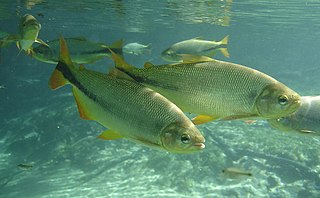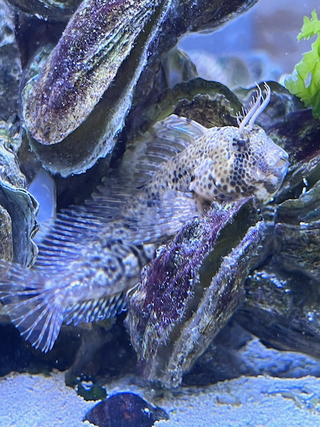
Poecilia is a genus of fishes in the family Poeciliidae of the order Cyprinodontiformes. These livebearers are native to fresh, brackish and salt water in the Americas, and some species in the genus are euryhaline. A few have adapted to living in waters that contain high levels of toxic hydrogen sulfide and a population of P. mexicana lives in caves.

Astyanax is a genus of freshwater fish in the family Characidae of the order Characiformes. Some of these fish, like many of their relatives, are kept as aquarium pets and known collectively as tetras. With around 150 described species and new ones being described yearly, this genus is among the largest of the entire order; Hyphessobrycon also has more than 145 species and which one is larger at any one time depends on whether more species have been recently described in one or the other. The blind and colorless cave tetra of Mexico is a famous member of the genus, but its taxonomic position is disputed: Some recognize it as part of the Mexican tetra and this is supported by phylogenetic evidence, but others recognize the cave form as a separate species, A. jordani.

Etheostoma is a genus of small freshwater fish in the family Percidae, and within the sub-family Etheostomatinae, native to North America. Most are restricted to the United States, but species are also found in Canada and Mexico. They are commonly known as darters, although the term "darter" is shared by several other genera. Many can produce alarm pheromones that serve to warn nearby fish in case of an attack.

Fundulus is a genus of ray-finned fishes in the superfamily Funduloidea, family Fundulidae. It belongs to the order of toothcarps (Cyprinodontiformes), and therein the large suborder Cyprinodontoidei. Most of its closest living relatives are egg-laying, with the notable exception of the splitfin livebearers (Goodeidae).

Apogon is a large genus of fish in the family Apogonidae, the cardinalfishes. They are among the most common fish on coral reefs. Over 200 species have been classified in genus Apogon as members of several subgenera. Some of these subgenera, such as Ostorhinchus, have been elevated to genus status, leaving just over 50 species in the genus.

Astroblepus is a genus of fish in the family Astroblepidae found in South America and Panama. This genus is the only member of its family. These catfishes are primarily found in torrential streams in the Andean area. Astroblepus pholeter and A. riberae are troglobites adapted to living in subterranean water systems. These species are typically small, less than 10 cm (4 in). The largest species reaches 30 cm (1 ft). These fish have suckermouths like those of loricariids. They have two pairs of barbels, maxillary and nasal. The dorsal fin spine lacks a locking mechanism. These fish also have odontodes, tiny teeth on their skin. All species exhibit a conical, pointy type on their fin rays like that found in other loricarioids; other species also exhibit a blunt type that is only found on their skin.

Cathorops is a genus of catfishes in the family Ariidae found in the Atlantic and Pacific Oceans. These species are found in the eastern and western Central and South America in brackish and freshwater habitats. This genus is a strongly supported clade of this family. It consists of a natural group in which the monophyly is well-defined by morphological and molecular evidence and the genus probably includes several unrecognized species from both American coasts.

Brycon is a genus of fish in the family Bryconidae and order Characiformes found in freshwater habitats in Central and South America, ranging from southern Mexico to northern Argentina. Despite not being closely related to true trout, they are sometimes called South American trout. Members of the genus may be referred to by a number of other different common names in various languages. They reach a maximum length of 11.9–79.5 cm (4.7–31.3 in) depending on the species involved. Some species perform seasonal breeding migrations.

Pimelodella is a genus of three-barbeled catfishes.

Myrichthys is a genus of snake eels currently containing 11 recognized species found in tropical and warm temperate oceans worldwide.

Chaetostoma, also known as the bristlemouth catfish, is a genus of suckermouth armored catfishes native to South America with one species, C. fischeri, extending into Panama. Most species inhabit flowing rivers in the lower Andes and its foothills. Some species are kept in unheated aquaria.

Hyporhamphus is a genus of halfbeaks. The species in this genus are distributed throughout the warmer seas of the world, most species being Indo-Pacific and there are some freshwater species.

Hypsoblennius is a genus of combtooth blennies found in the Pacific and Atlantic Oceans.
Anchoviella is a genus of anchovies, native to coastal parts of the tropical western Atlantic and eastern Pacific oceans, as well as rivers in South America.

Atherinella is a genus of Neotropical silversides from freshwater, brackish and marine habitats in Mexico, Central America and South America.

Strongylura is a genus of needlefishes from the family Belonidae which is distributed throughout the tropical and warmer temperate waters of the world, including some species which live in freshwater.

Paralichthys is a genus of large-tooth flounders. Most species are native to the coastal waters of the Americas, but P. olivaceus is from northeast Asia. The largest species reaches about 1.5 m (5 ft) in length.

Ctenogobius is a genus of gobies with a wide distribution in fresh, brackish and marine waters.

Microgobius is a genus of gobies native to the Pacific and Atlantic coasts of the Americas.

Pomadasys is a genus of grunts native to the waters of the eastern Atlantic Ocean and through the Indian Ocean to the Pacific coast of the Americas. The name of this genus is a compound of poma meaning "lid" or "covering" and dasys meaning "rough", a reference to the serrated preopercle.



















